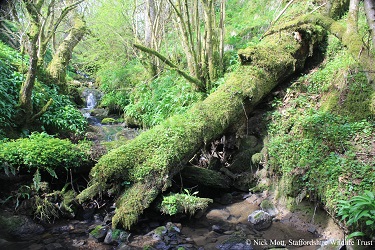Current ISIS code: W113
Previous assemblage name: W423 fast flowing streams and waterfalls.
Linked assemblage: n/a
Description of habitat typically supporting the assemblage: This is a distinctive SAT whose expression is currently handicapped by the small number of characteristic species. It may overlap with W112. It would benefit from have more samples and a re-ordination to establish a broader taxonomic footing.

The supporting streams are often small in width and on steep gradient, and may well cross more impervious rocks, resulting in waterfalls.
The assemblage type is found within and on the margins of fast-flowing streams, especially in moss on bedrock and boulders often in the splash zone of waterfalls and torrents. Typically, this assemblage type occupies ravines rather than river stretches with milder gradients undergoing net deposition. Suitable habitat can also be found in trickles on hard rock coastal cliffs. Most species that are characteristic of this assemblage type seem to be restricted to natural habitats, but some more widespread species can be found on weirs.

Sampling & assessing the assemblage
Standard sampling protocols apply.
Target groups: aquatic species, Coleoptera, Diptera.
Fieldwork methods: ground-searching, pond-netting, sweep-netting.
Alternative methods: n/a
Season: End of April-early July
Rocky, steep and wet sections require care. Direct pooting from marginal wet moss cushions may be useful, as will be careful sweeping, though it is easy to get the nets wet. Big pond nets may prove to be too unwieldy and smaller nets and sieves may be of more value. Wet timber of rocky Ghylls may also prove of interest.
Discrimination of conservation quality: discernible but compromised by poor expression
Default target: 3 species
